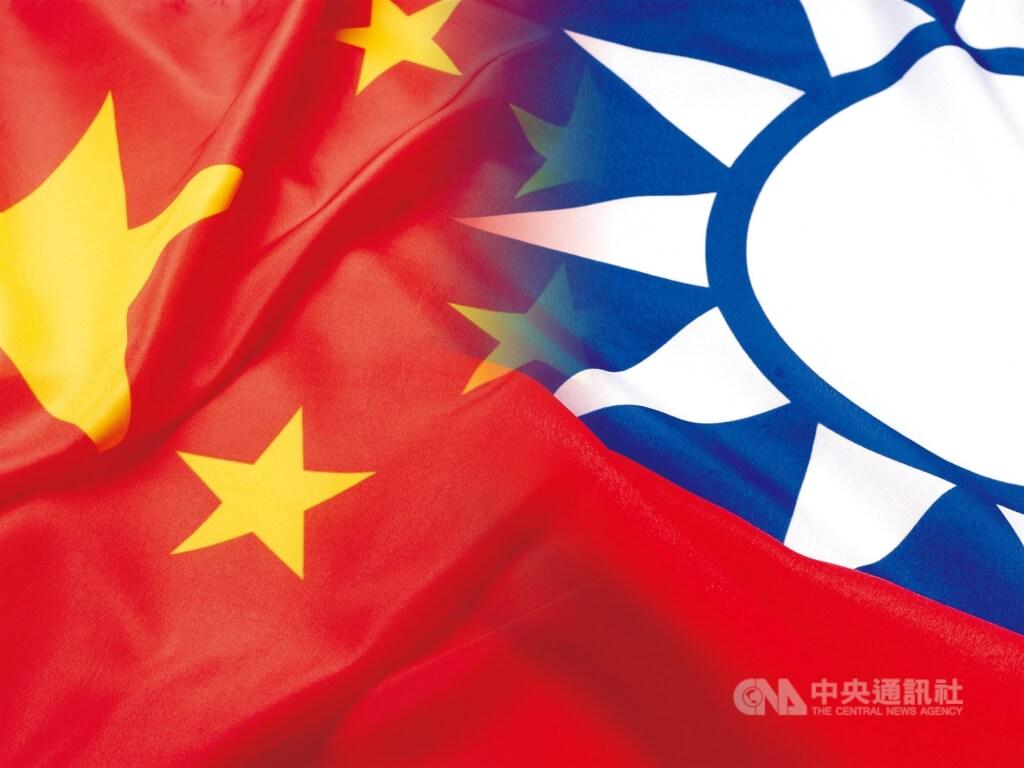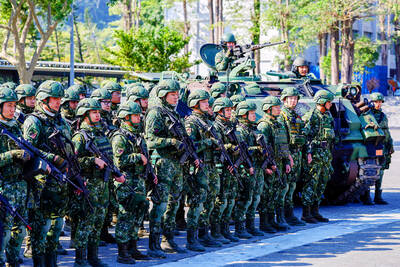The People’s Republic of China (PRC) issued two reward notices earlier this month for 21 Taiwanese military and military intelligence officers accused of “secessionist” activity, a “China-Taiwan Weekly Update” report published yesterday by US think tank American Enterprise Institute (AEI) said.
The move “likely marks a new PRC cognitive warfare effort to spread concern within the Taiwanese military, government and populace over the levels of PRC infiltration within the Taiwanese military,” the AEI said.
The PRC’s Ministry of State Security first issued reward notices on Oct. 10 for three lieutenant colonels in the Military Intelligence Bureau (MIB) for “conducting propaganda and sabotage efforts, spreading pro-independent messages and inciting cross-strait tensions online in violation of the PRC’s Anti-Secession Law,” it added.

Photo: CNA
The Chinese authorities released the three individuals’ photos, full names and identification numbers, reportedly provided by “concerned Taiwanese citizens,” the think tank said, which “suggests high levels of infiltration within the Taiwanese military and military intelligence apparatuses.”
The next day, the Xiamen Public Security Bureau issued a further reward notice offering 10,000 yuan (NT$43,033) for information leading to the capture of 18 military officers alleged to be members of a “‘psychological warfare’ unit conducting ‘secessionist’ activities online,” the report said.
The Ministry of National Defense said Beijing’s move is an “act of cognitive warfare,” “intended to divide public opinion and undermine the Taiwanese government,” the report said.
However, the notices are “unlikely to lead to arrests” as Taiwanese military officers rarely travel to China, the AEI said, though it could lead to “diminished public trust” in the Taiwanese military and reduced trust and security within the military.
The AEI noted a number of recent incidents, including the indictment on Oct. 12 of two military personnel on PRC espionage, after selling sensitive information to the PRC including the manual to the Hsiung Feng II anti-ship missile for US$1,200, and an EVA Air manager who on Oct. 14 confessed to acting as a PRC agent for 11 years.
The National Security Bureau (NSB) outlined four primary methods that the PRC uses to build espionage networks in Taiwan: using retired military personnel to recruit active-duty personnel, contacting targets online, using financial rewards and “exploiting targets’ indebtedness to coerce them,” which lines up with these latest incidents, the report said.
On Monday last week, Minister of National Defense Wellington Koo (顧立雄) said that the military is set to strengthen personnel screening to prevent further PRC infiltration.
China is engaging in cognitive and psychological warfare intended to intimidate and divide, taking advantage of Taiwan’s transparent, democratic society to gather data, he said today.
The military would now require retired and active-duty personnel to limit social media activity and is considering the use of aliases to prevent further data leaks, he said.
Additional reporting by CNA and Hsieh Chun-lin

UNILATERAL MOVES: Officials have raised concerns that Beijing could try to exert economic control over Kinmen in a key development plan next year The Civil Aviation Administration (CAA) yesterday said that China has so far failed to provide any information about a new airport expected to open next year that is less than 10km from a Taiwanese airport, raising flight safety concerns. Xiamen Xiangan International Airport is only about 3km at its closest point from the islands in Kinmen County — the scene of on-off fighting during the Cold War — and construction work can be seen and heard clearly from the Taiwan side. In a written statement sent to Reuters, the CAA said that airports close to each other need detailed advanced

Tropical Storm Fung-Wong would likely strengthen into a typhoon later today as it continues moving westward across the Pacific before heading in Taiwan’s direction next week, the Central Weather Administration (CWA) said. As of 8am, Fung-Wong was about 2,190km east-southeast of Cape Oluanpi (鵝鑾鼻), Taiwan’s southernmost point, moving westward at 25kph and possibly accelerating to 31kph, CWA data showed. The tropical storm is currently over waters east of the Philippines and still far from Taiwan, CWA forecaster Tseng Chao-cheng (曾昭誠) said, adding that it could likely strengthen into a typhoon later in the day. It is forecast to reach the South China Sea

Almost a quarter of volunteer soldiers who signed up from 2021 to last year have sought early discharge, the Legislative Yuan’s Budget Center said in a report. The report said that 12,884 of 52,674 people who volunteered in the period had sought an early exit from the military, returning NT$895.96 million (US$28.86 million) to the government. In 2021, there was a 105.34 percent rise in the volunteer recruitment rate, but the number has steadily declined since then, missing recruitment targets, the Chinese-language United Daily News said, citing the report. In 2021, only 521 volunteers dropped out of the military, the report said, citing

WEATHER Typhoon forming: CWA A tropical depression is expected to form into a typhoon as early as today, the Central Weather Administration (CWA) said yesterday, adding that the storm’s path remains uncertain. Before the weekend, it would move toward the Philippines, the agency said. Some time around Monday next week, it might reach a turning point, either veering north toward waters east of Taiwan or continuing westward across the Philippines, the CWA said. Meanwhile, the eye of Typhoon Kalmaegi was 1,310km south-southeast of Oluanpi (鵝鑾鼻), Taiwan’s southernmost point, as of 2am yesterday, it said. The storm is forecast to move through central